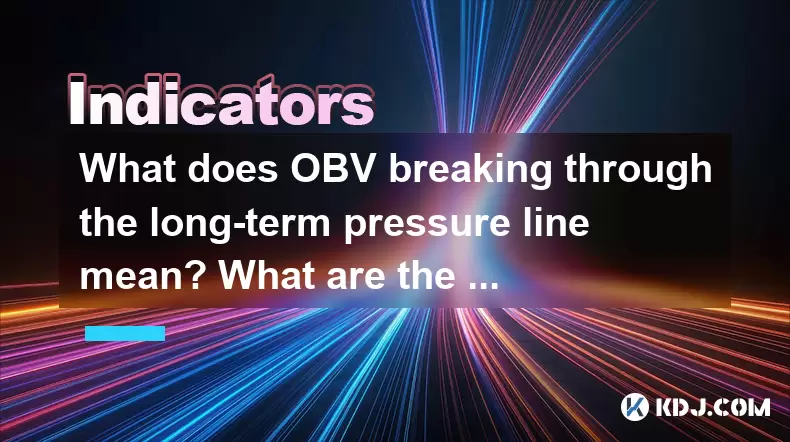-
 bitcoin
bitcoin $87959.907984 USD
1.34% -
 ethereum
ethereum $2920.497338 USD
3.04% -
 tether
tether $0.999775 USD
0.00% -
 xrp
xrp $2.237324 USD
8.12% -
 bnb
bnb $860.243768 USD
0.90% -
 solana
solana $138.089498 USD
5.43% -
 usd-coin
usd-coin $0.999807 USD
0.01% -
 tron
tron $0.272801 USD
-1.53% -
 dogecoin
dogecoin $0.150904 USD
2.96% -
 cardano
cardano $0.421635 USD
1.97% -
 hyperliquid
hyperliquid $32.152445 USD
2.23% -
 bitcoin-cash
bitcoin-cash $533.301069 USD
-1.94% -
 chainlink
chainlink $12.953417 USD
2.68% -
 unus-sed-leo
unus-sed-leo $9.535951 USD
0.73% -
 zcash
zcash $521.483386 USD
-2.87%
What does OBV breaking through the long-term pressure line mean? What are the signals of accelerated capital inflow?
OBV breaking through long-term pressure lines signals major shifts in market sentiment, often preceding significant price movements in cryptocurrencies like Bitcoin and Ethereum.
Jun 07, 2025 at 10:28 pm

Understanding OBV and Long-Term Pressure Lines
The On-Balance Volume (OBV) indicator is a technical analysis tool that measures buying and selling pressure by analyzing the cumulative volume. When the OBV breaks through a long-term pressure line, it suggests a significant shift in market sentiment and potential price movement. The long-term pressure line, often a trendline drawn over an extended period, acts as a resistance or support level for the OBV. When the OBV breaks above this line, it indicates that buying pressure is overcoming previous resistance, hinting at a bullish trend. Conversely, breaking below the line can signal a bearish trend.
Signals of Accelerated Capital Inflow
Accelerated capital inflow refers to a rapid increase in the amount of money entering the market. This can be identified through several signals. One of the primary indicators is a surge in trading volume, especially if it accompanies rising prices. Another signal is the increase in large transactions, often referred to as 'whale activity,' which can be tracked using blockchain analytics tools. Additionally, a sudden rise in open interest in futures markets can also indicate accelerated capital inflow, as it shows more investors are betting on future price movements.
How to Identify OBV Breaking Through Long-Term Pressure Lines
Identifying when the OBV breaks through a long-term pressure line requires careful observation of the OBV chart alongside the price chart. Here’s how to do it:
- Plot the OBV: Use a charting platform to plot the OBV on the same chart as the price. The OBV is calculated by adding the volume on up days and subtracting the volume on down days.
- Draw the Long-Term Pressure Line: Identify key resistance or support levels on the OBV chart over a significant period. Draw a trendline connecting these points to form the long-term pressure line.
- Monitor Breakthroughs: Watch for the OBV to break above or below this trendline. A clear break, confirmed by subsequent OBV values staying above the line, suggests a shift in market sentiment.
Case Studies of OBV Breakthroughs
To better understand the implications of OBV breaking through long-term pressure lines, let's look at some historical examples. In the case of Bitcoin in 2017, the OBV broke through a long-term resistance line in early 2017, which preceded a significant bull run. Similarly, Ethereum's OBV broke through a long-term pressure line in mid-2020, which was followed by a sharp increase in price. These examples illustrate how OBV can serve as an early indicator of major price movements.
Practical Steps to Monitor OBV and Capital Inflow
To effectively monitor OBV and signs of accelerated capital inflow, follow these steps:
- Select a Reliable Charting Platform: Use platforms like TradingView or Coinigy that offer advanced charting tools and OBV indicators.
- Set Up Alerts: Configure alerts on your charting platform to notify you when the OBV breaks through a long-term pressure line.
- Track Volume and Large Transactions: Use blockchain explorers and analytics platforms like Glassnode or CryptoQuant to monitor volume spikes and large transactions.
- Analyze Futures Market Data: Keep an eye on open interest in futures markets using platforms like Binance or Bybit to gauge investor sentiment.
Using OBV in Conjunction with Other Indicators
While OBV can provide valuable insights, it is most effective when used in conjunction with other technical indicators. Combining OBV with the Moving Average Convergence Divergence (MACD) can help confirm trends. For instance, if the OBV breaks through a long-term pressure line and the MACD shows a bullish crossover, it strengthens the case for a bullish trend. Similarly, using the Relative Strength Index (RSI) alongside OBV can help identify overbought or oversold conditions, adding another layer of analysis to your trading decisions.
Frequently Asked Questions
Q1: Can OBV be used for short-term trading strategies?Yes, OBV can be adapted for short-term trading by using shorter time frames for the OBV calculation and monitoring shorter-term pressure lines. However, it is generally more reliable for longer-term trend analysis.
Q2: How does OBV differ from volume analysis?While volume analysis looks at the total number of shares or coins traded, OBV takes into account the direction of the price movement along with the volume. This makes OBV a more nuanced tool for understanding buying and selling pressure.
Q3: Is OBV effective for all cryptocurrencies?OBV can be applied to any cryptocurrency with sufficient trading volume. However, its effectiveness may vary depending on the liquidity and market dynamics of the specific cryptocurrency.
Q4: How often should I check the OBV and long-term pressure lines?It's advisable to check the OBV and long-term pressure lines at least daily if you are an active trader. For longer-term investors, weekly checks may suffice, but always stay alert for significant market movements.
Disclaimer:info@kdj.com
The information provided is not trading advice. kdj.com does not assume any responsibility for any investments made based on the information provided in this article. Cryptocurrencies are highly volatile and it is highly recommended that you invest with caution after thorough research!
If you believe that the content used on this website infringes your copyright, please contact us immediately (info@kdj.com) and we will delete it promptly.
- Ray Dalio's Portfolio Prescription: Why Bitcoin and Gold Are Essential in a Debt-Ridden World
- 2025-12-19 01:35:01
- Taiwan's Bitcoin Trove: Criminal Investigations Unearth a Surprising Global Ranking
- 2025-12-19 01:30:02
- Coinbase's Bold Leap: Stocks, Prediction Markets, and the Future of Trading
- 2025-12-19 01:35:01
- Kaito, Kickstarter, and the Post-TGE Crash: Navigating Crypto's Volatile Launch Landscape
- 2025-12-19 01:15:01
- Jito Foundation's Onshoring Signals a New Dawn for Solana and Crypto Regulation in the US
- 2025-12-19 01:25:01
- Cardano's Midnight Token (NIGHT) Shines Amidst Crypto Economy Evolution, Highlighting Privacy and Next-Gen Potential
- 2025-12-19 01:15:01
Related knowledge

How to Combine Japanese Candlesticks with Western Chart Patterns (like Head and Shoulders)?
Dec 04,2025 at 02:40pm
Understanding Japanese Candlesticks in Modern Trading1. Japanese candlesticks offer a visual representation of price movement within a specific timefr...

A Deep Dive into the Three Outside Up/Down Patterns for Crypto Traders.
Dec 17,2025 at 07:39am
Understanding the Three Outside Up Pattern in Crypto Markets1. The Three Outside Up pattern is a bullish reversal formation that typically appears at ...

Can a Gravestone Doji at a Key Resistance Level Signal a Perfect Short Entry?
Nov 28,2025 at 09:40pm
Understanding the Gravestone Doji in Technical Analysis1. The Gravestone Doji is a candlestick pattern characterized by an opening and closing price t...

What Do Overlapping Candlesticks Reveal About Support and Resistance in Crypto?
Dec 13,2025 at 08:39am
Understanding Overlapping Candlesticks in Crypto Charts1. Overlapping candlesticks occur when multiple price candles on a chart share similar high or ...

How to Tell if a Crypto Breakout is Real Using Candlestick and Volume Analysis?
Nov 28,2025 at 05:39am
Understanding the Anatomy of a Genuine Crypto Breakout1. A true breakout in the cryptocurrency market is not defined solely by price surpassing a resi...

The Definitive Guide to Entry and Exit Points Using Crypto Candlestick Patterns.
Nov 29,2025 at 06:59am
Understanding Bullish Reversal Patterns1. The hammer candlestick pattern typically appears at the end of a downtrend and signals a potential reversal....

How to Combine Japanese Candlesticks with Western Chart Patterns (like Head and Shoulders)?
Dec 04,2025 at 02:40pm
Understanding Japanese Candlesticks in Modern Trading1. Japanese candlesticks offer a visual representation of price movement within a specific timefr...

A Deep Dive into the Three Outside Up/Down Patterns for Crypto Traders.
Dec 17,2025 at 07:39am
Understanding the Three Outside Up Pattern in Crypto Markets1. The Three Outside Up pattern is a bullish reversal formation that typically appears at ...

Can a Gravestone Doji at a Key Resistance Level Signal a Perfect Short Entry?
Nov 28,2025 at 09:40pm
Understanding the Gravestone Doji in Technical Analysis1. The Gravestone Doji is a candlestick pattern characterized by an opening and closing price t...

What Do Overlapping Candlesticks Reveal About Support and Resistance in Crypto?
Dec 13,2025 at 08:39am
Understanding Overlapping Candlesticks in Crypto Charts1. Overlapping candlesticks occur when multiple price candles on a chart share similar high or ...

How to Tell if a Crypto Breakout is Real Using Candlestick and Volume Analysis?
Nov 28,2025 at 05:39am
Understanding the Anatomy of a Genuine Crypto Breakout1. A true breakout in the cryptocurrency market is not defined solely by price surpassing a resi...

The Definitive Guide to Entry and Exit Points Using Crypto Candlestick Patterns.
Nov 29,2025 at 06:59am
Understanding Bullish Reversal Patterns1. The hammer candlestick pattern typically appears at the end of a downtrend and signals a potential reversal....
See all articles









































































